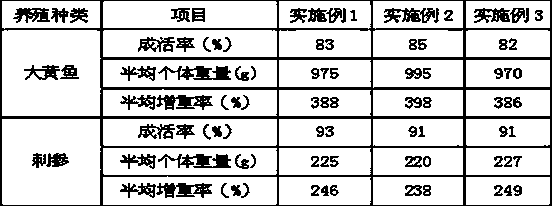Method for alternately cultivating pseudosciaena crocea and stichopus japonicus
The technology of a large yellow croaker and a breeding method is applied in the field of rotation breeding of large yellow croaker and sea cucumber, which can solve the problems of prolonged breeding cycle, weak disaster bearing capacity, poor quality and taste, etc., so as to improve the environment of breeding sea areas, ensure continuous supply, The effect of improving utilization
- Summary
- Abstract
- Description
- Claims
- Application Information
AI Technical Summary
Problems solved by technology
Method used
Image
Examples
Embodiment 1
[0035] Cages are arranged in the sea area of Zhejiang. The area of the cage culture area is equal to 10% of the aquaculture area of the sea area, 150 m away from the shore. The cage specifications are: length 10 m×width 10 m×height 10 m, mesh size 50 mm, and the cages are formed into net rafts with a culture water body of 40,000 m3. There is a 55-m channel between the net rafts. In early April, large yellow croaker fingerlings were placed in the net cages in the sea area of Zhejiang. Immerse in 10ppm potassium permanganate solution for 30 minutes, and the stocking density of fingerlings is 70 fish / m 3 , it is forbidden to feed the bait on the 1st to 3rd day after the fish species are put in. On the 4th to 10th day, feed the bait once a day, and the bait feeding amount is 1% of the fish body weight. The morning feeding time is 8:00~9:00, the bait feeding amount is 2% of the fish body weight, the afternoon feeding time is 16:00~17:00, the bait feeding amount is 3.5% of...
Embodiment 2
[0039] The net cages are arranged in the sea area of Zhejiang. The area of the net cage culture area is equal to 9% of the aquaculture area, 270m away from the shore. 45 mm, and the net cages are formed into net rafts with a culture water body of 30,000 m3. There are 50 m passages between the net rafts. Immerse in 20ppm potassium permanganate solution for 10 minutes, and the stocking density of fingerlings is 50 fish / m 3 , it is forbidden to feed the bait on the 1st to 3rd day after the fish species are put in. On the 4th to 10th day, the bait is fed once a day, and the bait feeding amount is 1.5% of the fish body weight. The morning feeding time is 8:00~9:00, the bait feeding amount is 2.5% of the fish body weight, the afternoon feeding time is 16:00~17:00, the bait feeding amount is 3% of the fish body weight, continuous After feeding for 5 days, stop feeding for 2 days, and then cycle feeding according to this cycle. During the large yellow croaker breeding period, do ...
Embodiment 3
[0043] Cages are arranged in the sea area of Zhejiang. The area of the cage culture area is equal to 8% of the aquaculture area, 300m away from the shore. The cage specifications are: length 10 m×width 10 m×height 10 m, mesh size 30 mm, and the net cages are formed into net rafts with a culture water body of 35000m3. There are 60m channels between the net rafts. Soak in 20ppm formalin for 20 minutes, and the stocking density of fingerlings is 40 fish / m 3 , it is forbidden to feed the bait on the 1st to 3rd day after the fish species are put in. On the 4th to 10th day, feed the bait once a day, and the bait feeding amount is 2% of the fish body weight. The morning feeding time is 8:00~9:00, the bait feeding amount is 3% of the fish body weight, the afternoon feeding time is 16:00~17:00, the bait feeding amount is 4% of the fish body weight, continuous Feed for 7 days and then stop feeding for 2 days, and feed them in a cycle. During the large yellow croaker breeding period...
PUM
 Login to View More
Login to View More Abstract
Description
Claims
Application Information
 Login to View More
Login to View More - R&D
- Intellectual Property
- Life Sciences
- Materials
- Tech Scout
- Unparalleled Data Quality
- Higher Quality Content
- 60% Fewer Hallucinations
Browse by: Latest US Patents, China's latest patents, Technical Efficacy Thesaurus, Application Domain, Technology Topic, Popular Technical Reports.
© 2025 PatSnap. All rights reserved.Legal|Privacy policy|Modern Slavery Act Transparency Statement|Sitemap|About US| Contact US: help@patsnap.com

